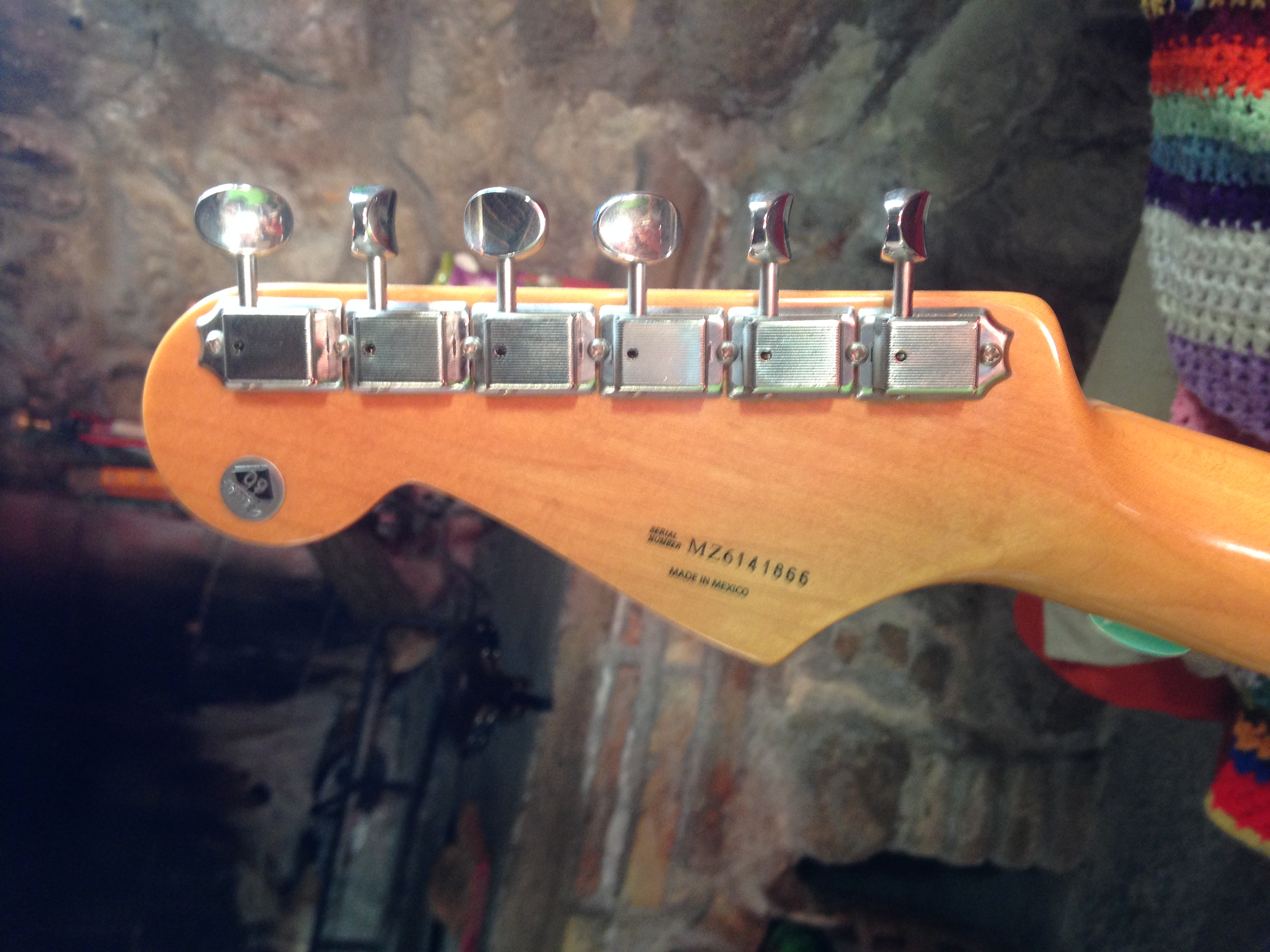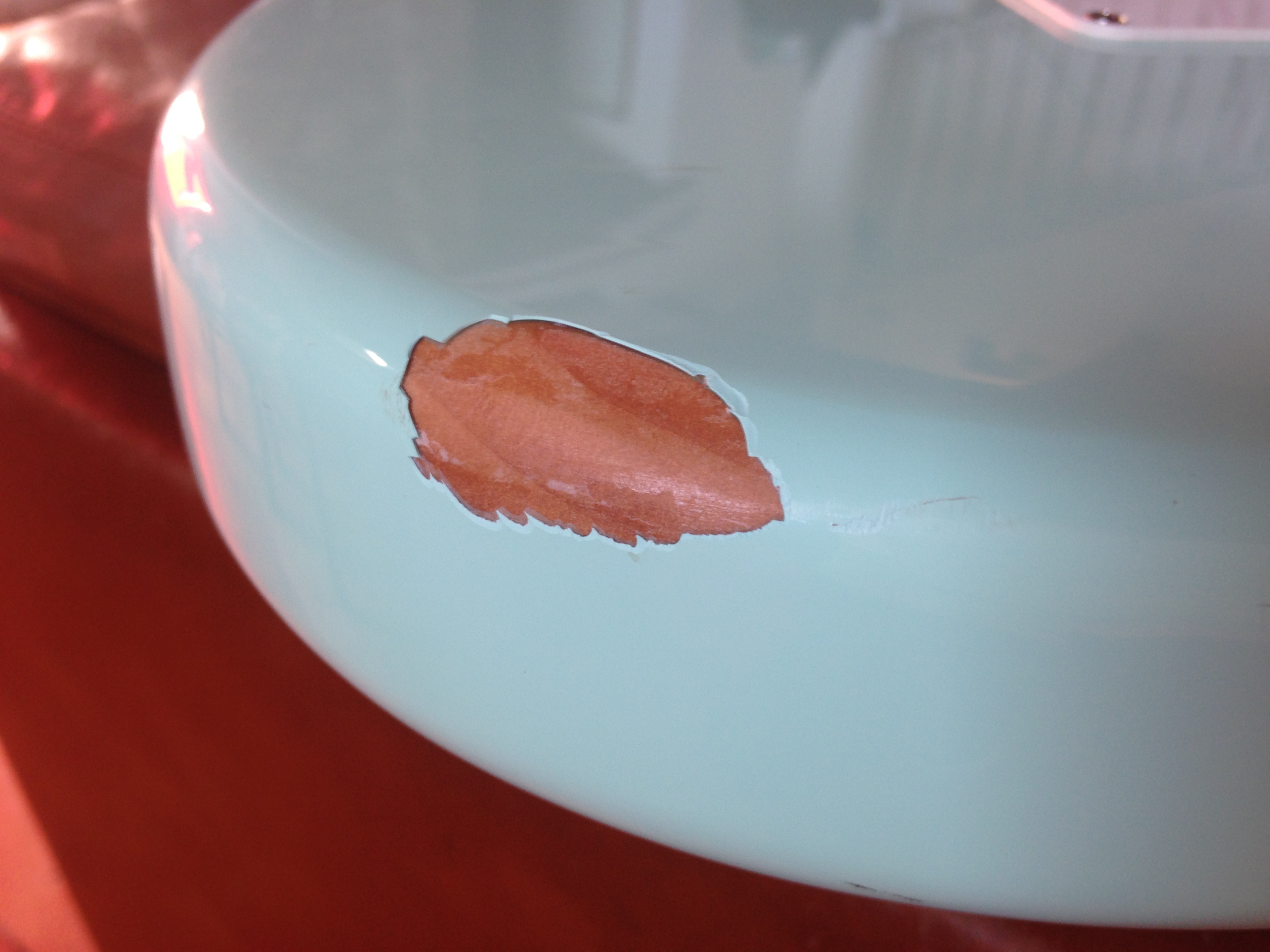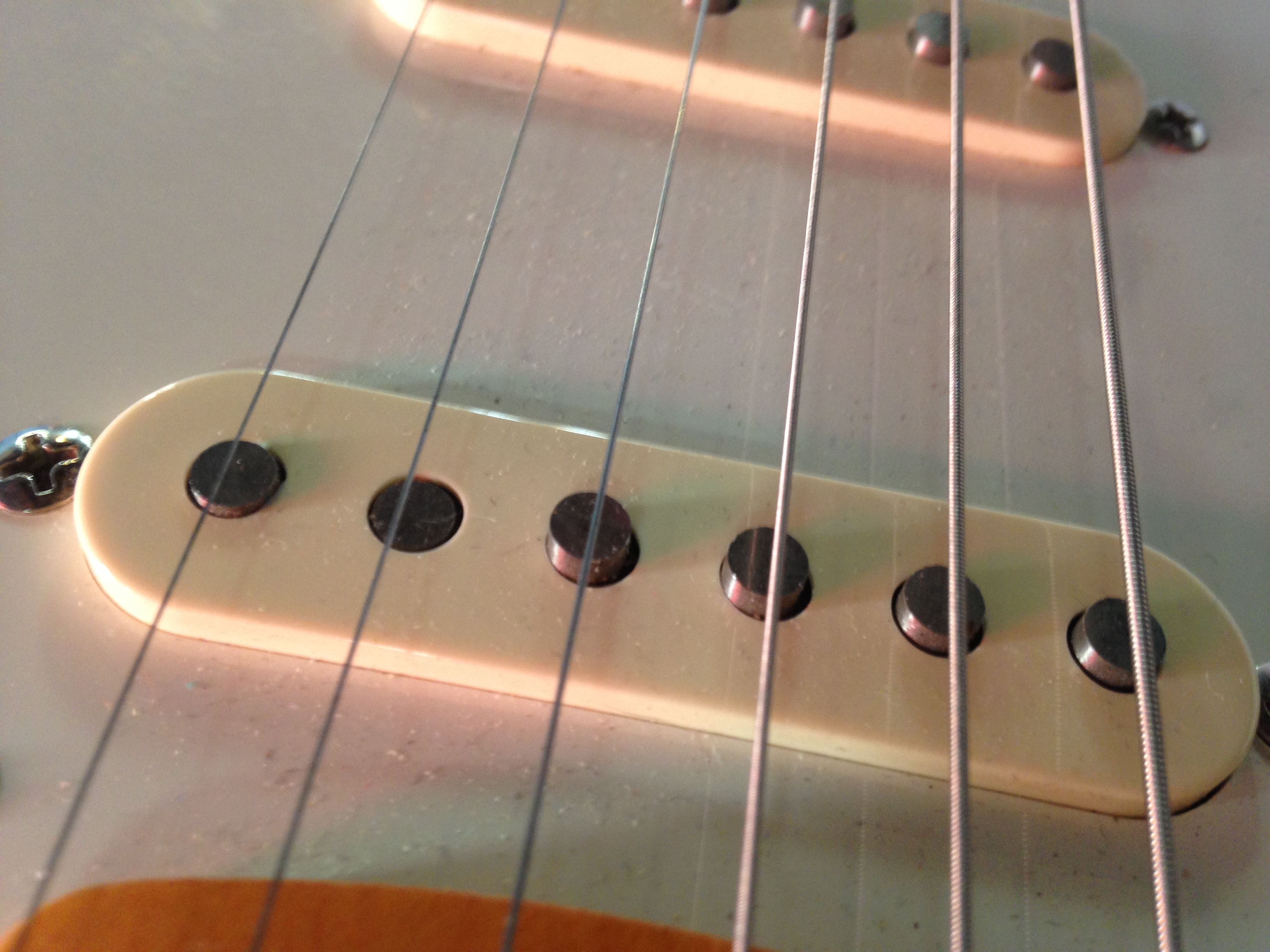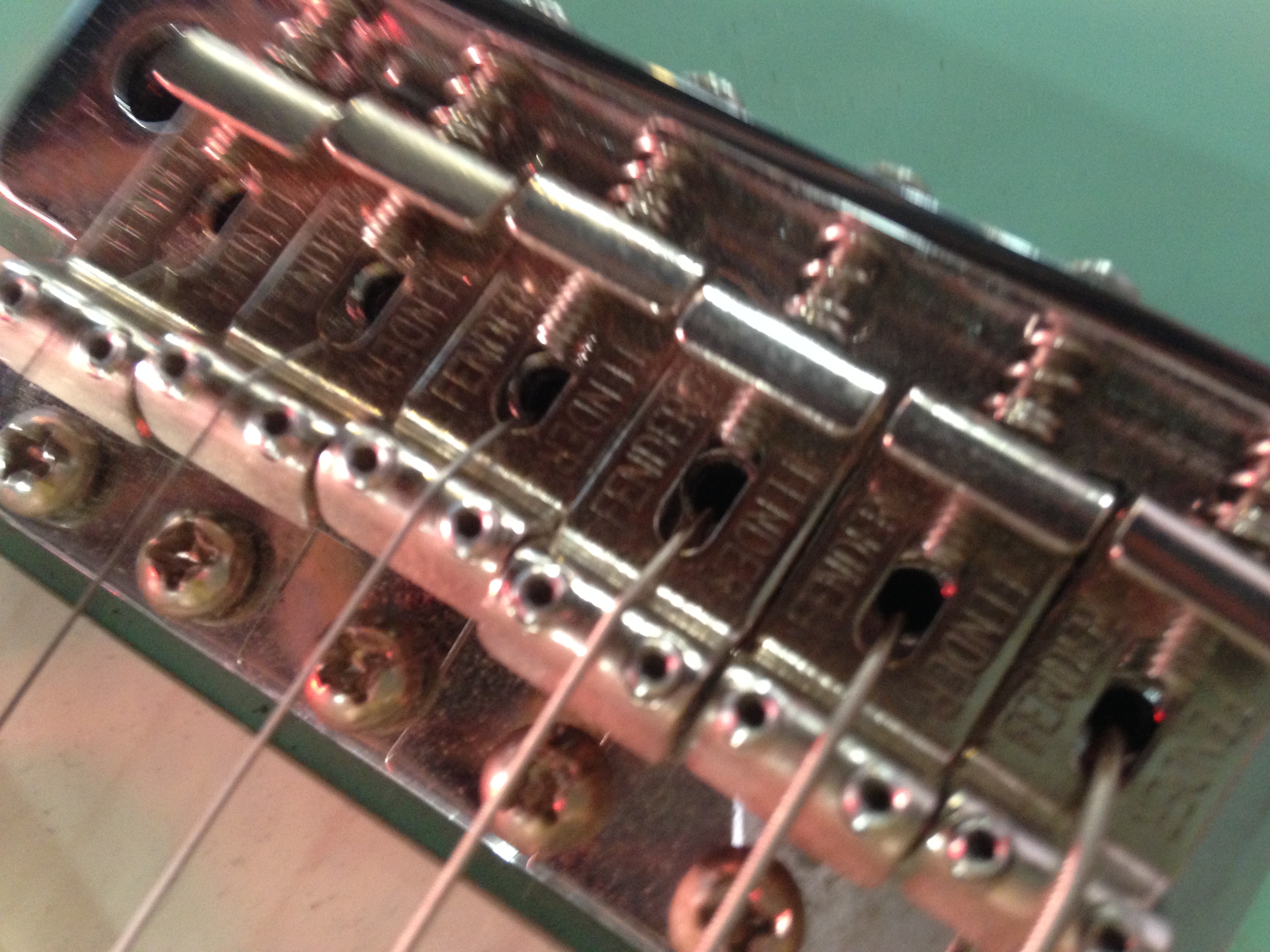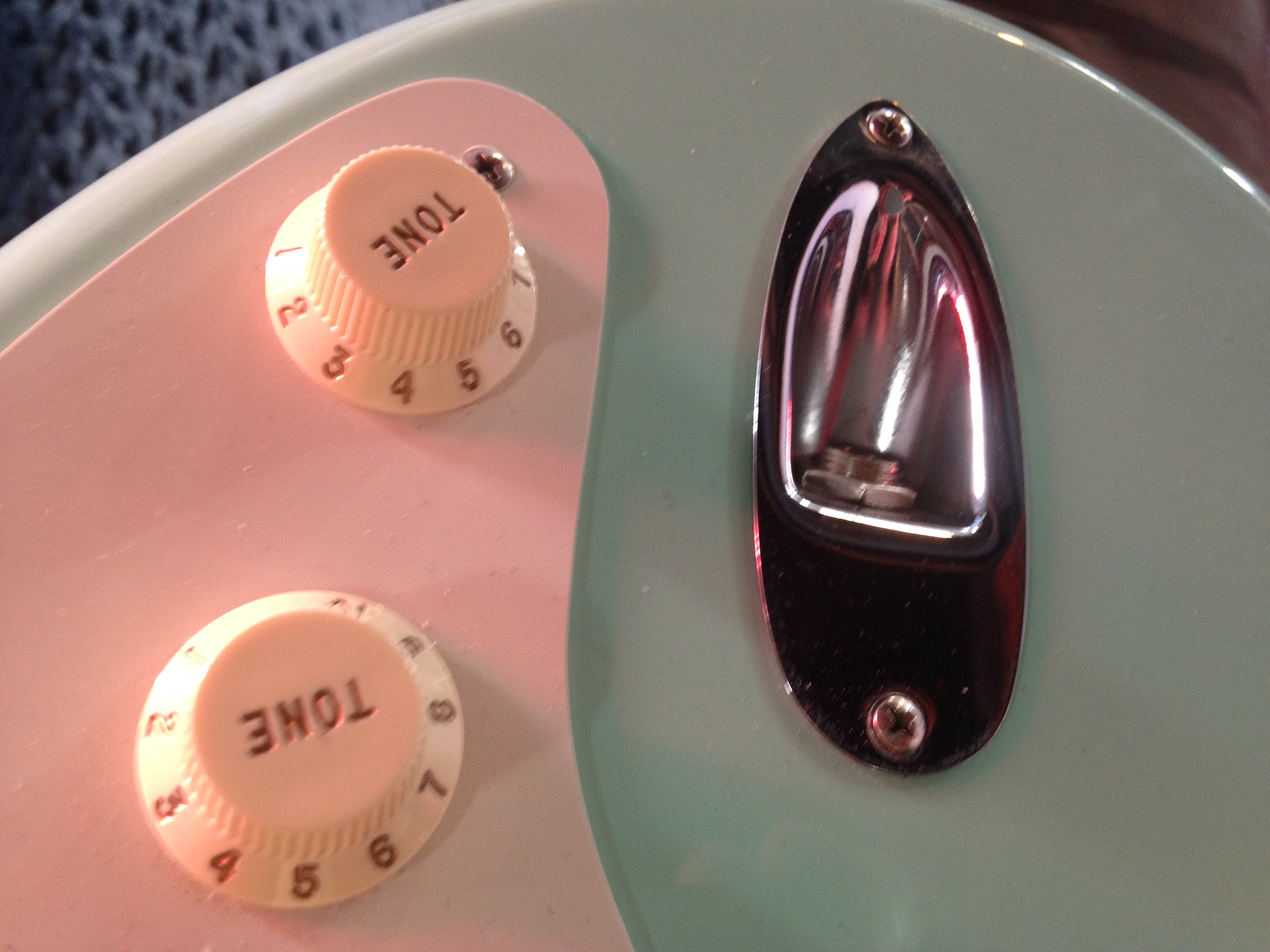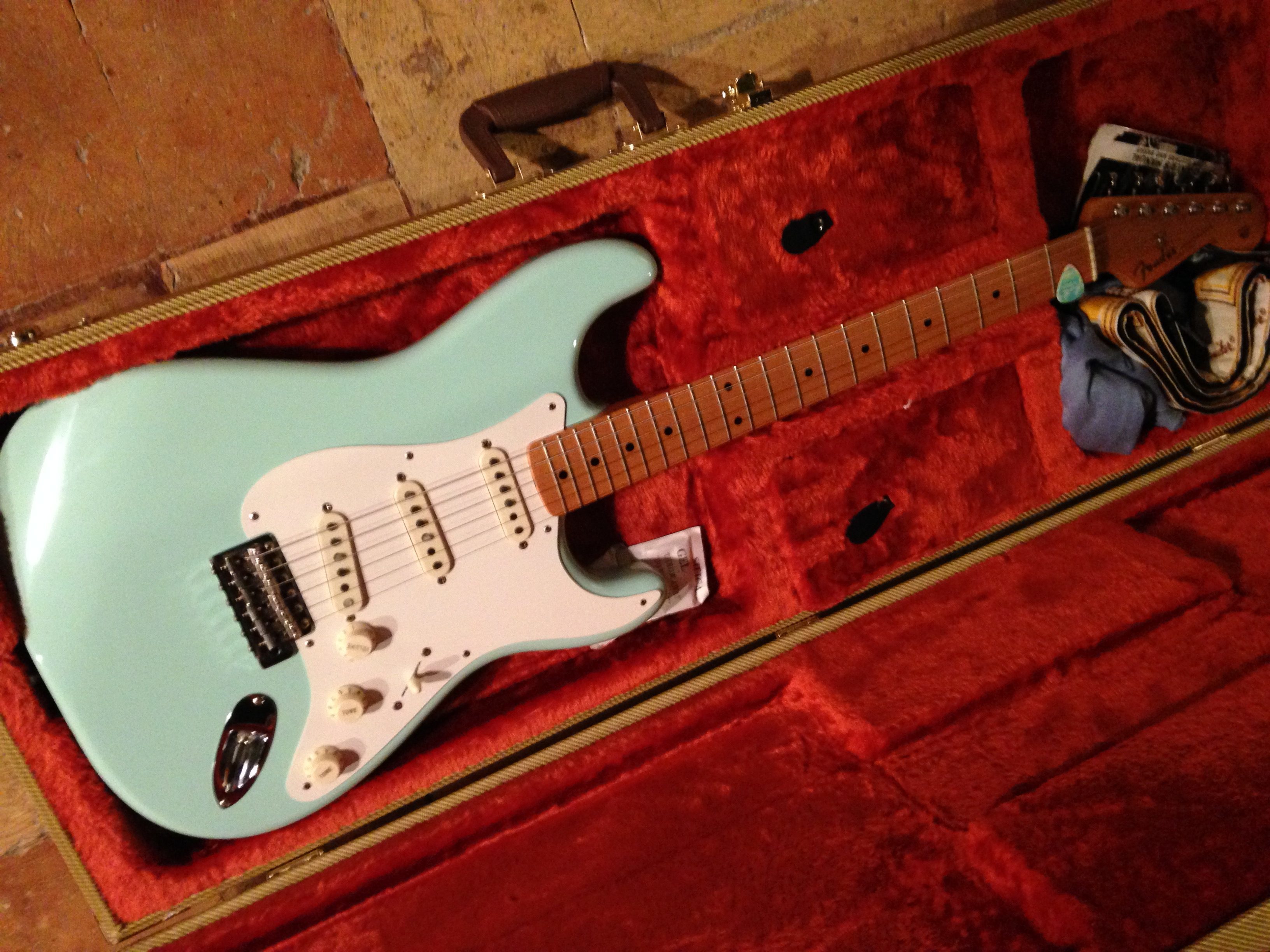
My beautiful Fender Stratocaster Classic, 56 reissue, in her Fender Tweed flight case she deserved and that I bought for her
Finally, on November 2016, I fulfilled my dream of having a real Fender Stratocaster. Just by chance, I happened to stumble upon the ad of a model I would have probably chosen even if I had been buying new. It is a reissue of the 50s in a shiny Surf Green color, my favorite of the times, reminiscent of the fashion of those years, of the American cars that were painted with colors Leo Fender also used for his guitars.
Made in Mexico Stratocasters? Why not!
I admit that if I could have afforded it, I would have gone for an American Vintage 50s. I had to be “satisfied” with a Classic Series, a Made in Mexico (MIM) reissue, instead of a Made in America (MIA) one. Is that bad? Absolutely not. Some people snob MIM Strats: they cost much less than the American counterparts, they are supposed to be built with lesser quality materials and lower workmanship. There is maybe some lurking racism in those statements, which does not take into account facts like the many Mexican workers Fender employed since the 50s, who assembled a huge number of MIA guitars.
The main reason for the lower prices of MIM guitars is the big difference in labor cost compared to the United States: a Mexican worker costs much less, so a MIM Fender can be sold at much lower prices, with no need to save on materials or assemblage.
Having said that, there are some differences also in the materials used for building those guitars. After all, the point is to offer affordable Fender guitars (MIMs) and also more “precious” instruments with selected components (MIAs), that do not necessarily mean lower performances. In the situation I’m in today, it was the obvious choice…
What’s really different between a 50s Stratocaster reissue made in Mexico or in America? In summary, the body paint is polyurethane instead of nitro finish. The metal parts (tuners and tremolo bridge) are cheaper. The internal wiring and some electrical components are also cheaper. The pickups in the Classic Series are very good vintage spec’d staggered Alnico V pole pieces unit, not necessarily the weak point. For the rest it is a matter of wood parts quality – as someone puts it: a piece of wood is a piece of wood. The Mexican-made Classic Series (and todays Vintera series) are said to be the poor man’s AVRIs. With time you can upgrade the various parts to match the USA-made ones and ultimately you can also have the body repainted.
Let’s try to shed some light.
My Stratocaster was assembled in the Ensenada factory in Mexico in July 2006. It was the reproduction of the model sold in 1956, therefore she carries the 60th anniversary badge.
Body and paint
The main difference between American and Mexican Stratocaster reissues is the paint. The body is usually made of alder and apparently MIMs use more pieces than the MIAs (which should be made of two pieces maximum). American reissues are painted with nitrocellulose while the Mexican ones are in polyurethane. This is a big argument on the network, to the point that someone really believes there are sound differences with different paints! This is nonsense. By the way, all my bandmates agree I have a “killer tone” now!
The two paints are completely different, though: nitro becomes part of the wood and is very sensitive to time and usage. After years, it may start to fade and the parts you touch most can lose the coating so the wood may become visible underneath. Many love nitro for this very reason. After years of playing the guitar is personalized and has that “road worn” look that vintage geeks love so much. The modern, almost 1-mm thick poly coatings, are rather indestructible. They will stay as they are forever if you don’t damage them. It is cheaper, though, so it is the smart choice for more affordable guitars.
Not even one month after having bought my much desired Fender Stratocaster, my wife made her fall from the couch where I had inadvertently left her (the guitar, I mean). So I have immediately begun the personalization process of my new Stratocaster. Maybe one day I will decide for a complete nitro vintage repaint. It must be said that the old nitrocellulose used in the 50s and 60s is no longer available since it is toxic and forbidden since long ago. Today’s nitro paint used on American reissues (AVRI) is not the same, but something between modern synthetic nitrocellulose and polyuretane. The tactile feeling is different but I don’t think it is worth the 300 euro effort now.
The pickguard
Let’s see what it is about the other features of this guitar. Except the Made in Mexico label on the rear of the peghead, nothing gives away the fact that it has been assembled in Ensenada. Actually, the wooden parts are carved in Corona, California, and shipped across the border in Mexico (merely a 3-and-a-half-hour drive) where they are painted, labelled in a state-of-the-art factory that the managers keep tidy and clean, well aware of the prejudices about them.
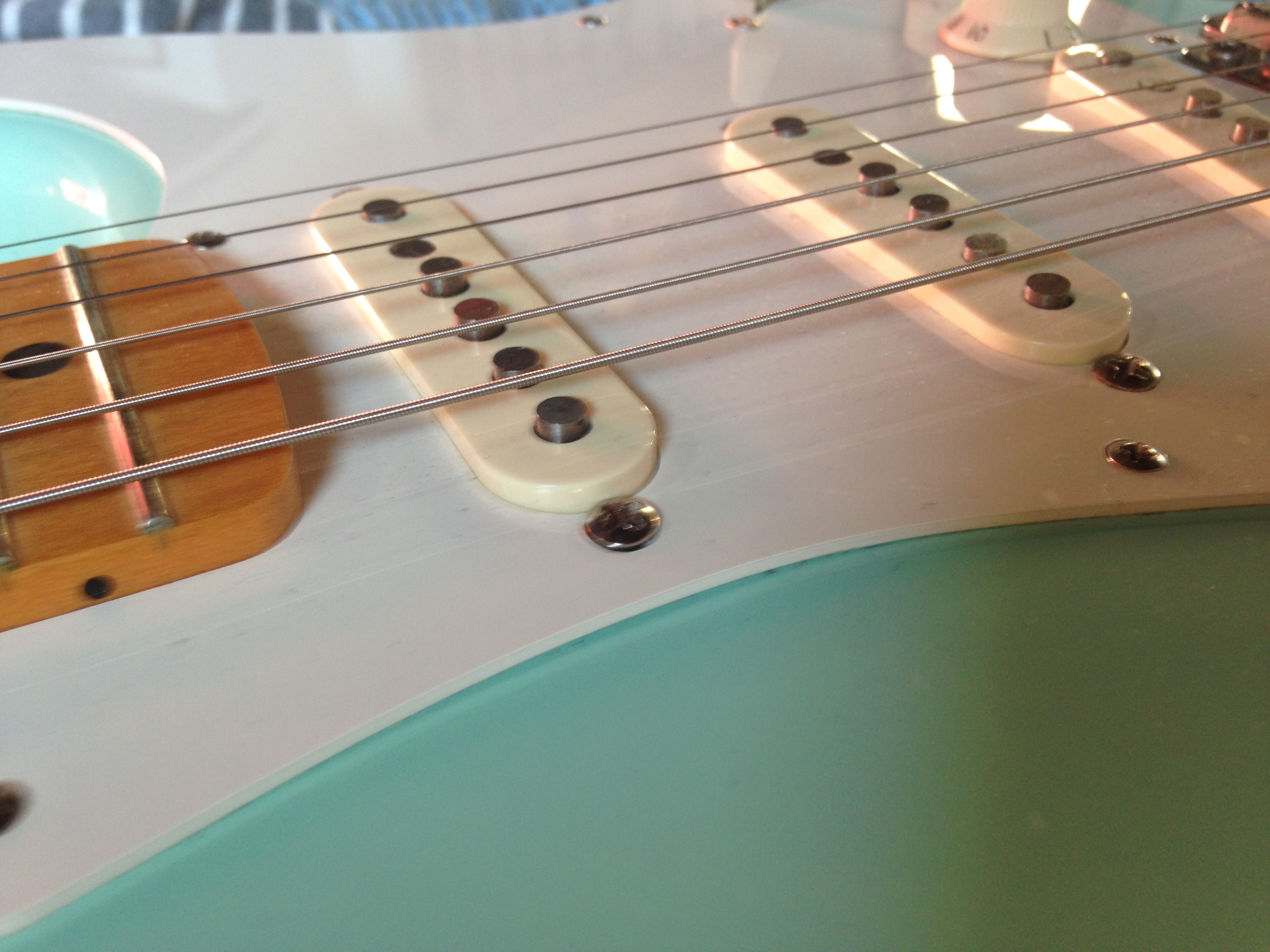
The 1-ply, 8-screw pickguard was typical of the 50s; here it leaves a gap with the body in the space between two screws. Not really nice to see, but nothing serious…
Some talk about a less than perfect assemblage of Mexican Fenders. I have no experience with AVRIs but my former guitar was a Paul Reed Smith, the quality of which nobody dare doubt about. My new MIM Strat does not seem to suffer bad assemblage or refinement. Maybe the only problem in this respect is about her being a reissue of a 50s Stratocaster: early pickguards were of 1-ply cheap plastic mounted on the body by means of 8 screws. They were easily damaged and broke fast. In the 60s, Fender changed the pickguards with more resistant 3-ply (the middle one was black, so to highlight the change), 11-screw pickguards (a note: the material came from Italy, which was strong in the plastics business at the time). Today, spare pickguards are available, featuring 3-ply and 8 screw holes, so that if one day I’d want to update mine, I would be able to. The real weak spot of early Strats was maybe just the 1-ply pickguard. I don’t know if this is an issue on American reissues too. Today at Fender they use more modern and resistant plastic materials. Yes, the top edge of my pickguard does not touch the body very firmly between two screws. It could be my first, and possibly only upgrade I could make. I’m not sure I really need it, but one idea would be a 1-ply, 8 screws pickguard from Callaham (so I would keep the 50s look), with a metal plate to better insulate the insides of the Strat.
I will maybe have to change the little springy rubber tubes that contain the pickup adjustment screws: they are easily worn and may cause a longitudinal tilt of the pickups. In fact, my middle pickup is slightly facing towards the neck. There are metal springy spares that avoid this issue, which appears to be typical of Stratocasters.
The same applies for the tremolo cover plate in the rear. Eventually, like many do, I also decided to leave the routing open. This way I have easier access to the tremolo screws for adjustments and string replacements, and it also limits internal resonance issues.
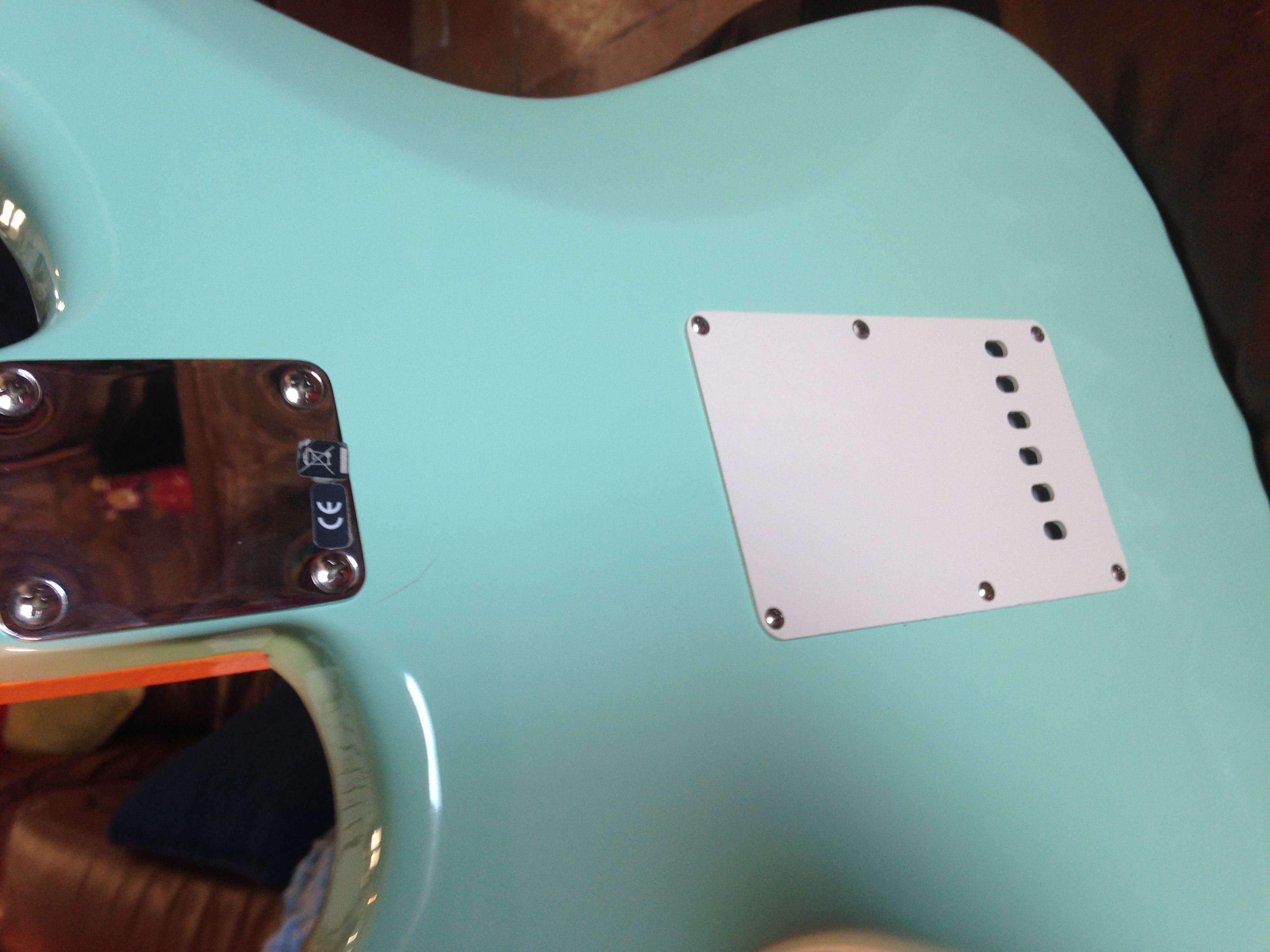
The tremolo cover plate on the rear of my Classic 50s: 1-ply like it used to be. Even the neck plate it is supposed to be of lower quality than the MIAs: really simple upgrade, maybe with a nice stylish capital F…
The Kluson tuners
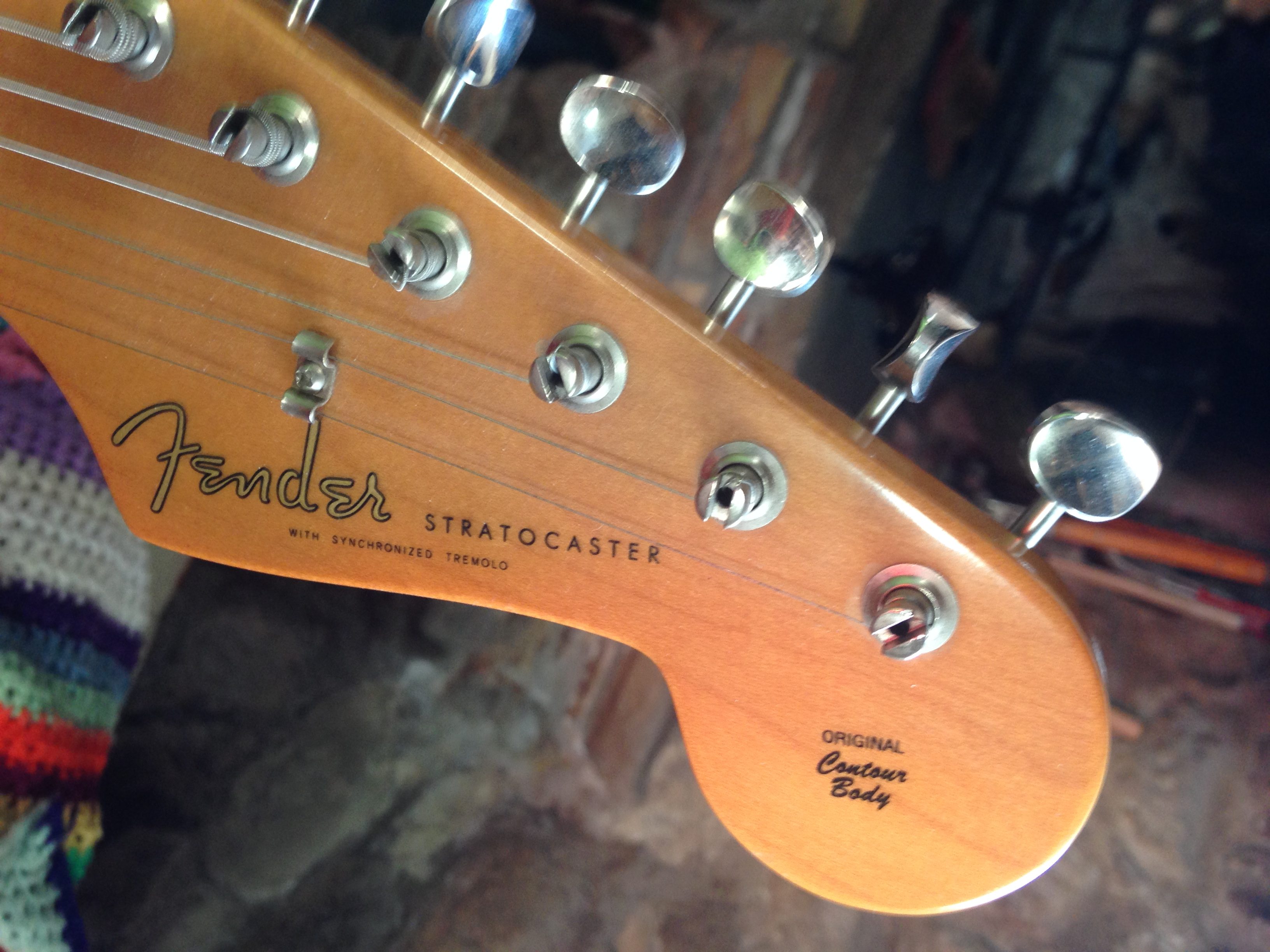
Front view of the Kluson-style tuners made by Ping – Mexican reissues made in the 2000s do not have a “made in Mexico” label on the peghead – why should they? They are no less than their relatives across the border; sometimes, the opposite is true…
In the golden years Fender used tuners made by Kluson. My guitar has the “vintage” reproduction of the era, with the characteristic slot where to insert the strings. MIM Strats use reproductions made by the Taiwan-based company Ping; MIAs use the Kluson-type made in Japan by Gotoh. Any differences? It seems that the Gotoh tuners are the best, also used on the American Vintage series. So I made plans to upgrade one day. When the time came I chose the Kluson M6V0C, now made by Gotoh in Japan. Compared to the Gotoh ones mentioned above, they also have the Deluxe lettering on the back, in the middle of the gear cover, as they were in the 50’s (in the 60’s they have a double Deluxe lettering, i.e. on two lines). They are an almost perfect replacement, the problem is the bushings to fit in the neck holes. The original bushings do not allow the Kluson tuning machines to be inserted, the Kluson replacement bushings are slightly longer and a little narrower: the holes are slightly wider and the bushings do not hold, they have to be wrapped with something to secure them in the holes. The rest is a matter of disassembling the old ones and reassembling the new ones. I used the original screws, the replacement ones are longer and I didn’t feel like forcing them into the wood. I also read that they were of very bad quality… better to leave the original ones. You perceive a higher quality and greater precision in use. And then they are aesthetically more adherent to how the Stratocasters of that era were.
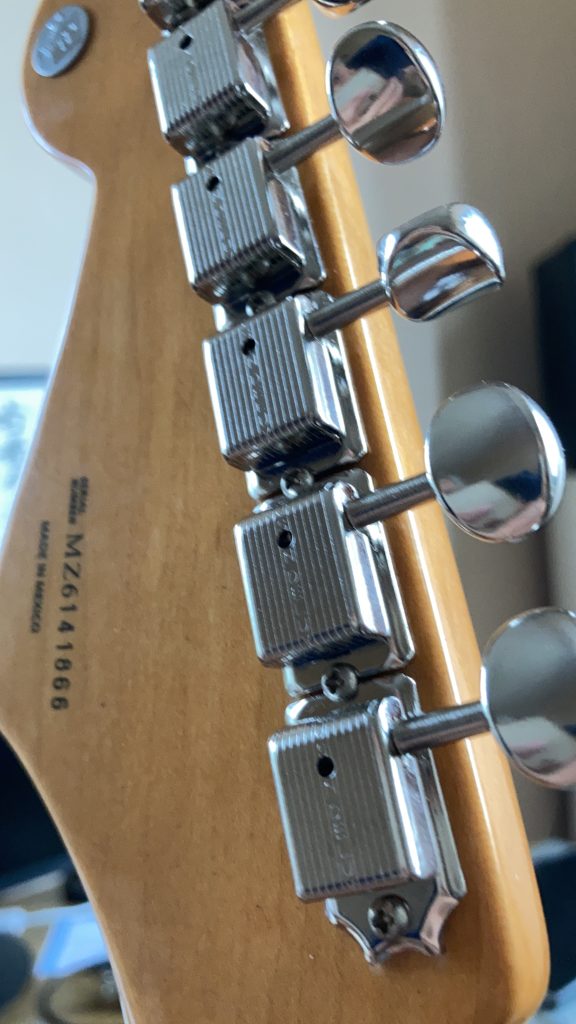
In 2021 I mounted some nice Kluson by Gotoh tuning machines, the Single-Line Deluxe, with the lettering engraved in the middle of the gear covers. Just like in the 50’s…
The only weird thing I noticed is the string tree’s placement, the tiny metal piece that lowers the strings to the peghead surface. Most of old and new Stratocaster pictures show the string trees at level with the 2nd tuning machine; my specimen has it almost at the 3rd. It’s a rare placement to find. A mistake of the Mexicans or a choice? Or simply a rarity? I don’t know, but it seems the more advanced placement allows for a more stable tuning since it provides a lower string tension towards the tuner.
A tweak would be upgrading to much modern staggered tuning machine, meaning the tuning pegs are shorter for the thinner strings, making the string tree useless. I wouldn’t like a hole showing on my Strat’s peghead, therefore I’m not interested – Now that I have replaced the Pings with the Klusons I am all right.
A few words about the nut: original nuts were made of bone, like the American made reissues of today. Mexican reissues have a synthetic bone nut. So what? It is eco-frendly and more sustainable, ok? I’ve got nothing against it. What about you? I could maybe replace it with one in brass or graphtek, the modern suitable material. But no, I would go for bone in that case. But the real point is that it must have been carved correctly: each slot should be dimensioned according to the string gauge (thinner strings should have shallower and narrower slots). The Classic Series 50s mounts .010 – .046″ strings – theoretically, if you change gauge you should also change the nut accordingly.
Neck and fretboard
Some nonsense about it: the Stratocasters of the 50s had a freatboard radius of 7.25 inches, lower than modern ones that can also feature a 16″ radius. My former PRS had a 10″ radius fretboard (the higher the number, the flatter the fretboard curvature). Some say that with a low curvature radius, bending becomes not easy: the string would go against the fretboard curvature and would stop vibrating (fret out). Older guitars were played most with chords on the lower register and the high curvatured made barré chords easier. The development of more modern playing styles and soloing induced the production of flatter fretboards for easier bending. Actually, a good setup makes a vintage fretboard perfectly playable …even for me…
My Stratocaster has a wonderful maple neck with glossy finish and a Soft V profile. Maybe a satin finish like in the MIAs would be more comfortable. I could have it done by a luthier. The fretboard is carved directly on the neck, not glued on. The frets are obviously vintage-sized, therefore thin. Another subject for arguments: thin frets allow a better intonation but more difficult bending and faster wearing out. Ok, when the time comes, frets can be replaced…
Pick ups
Lot’s of arguments also about the vintage pickups – they were staggered, their magnetic poles had different heights: those under the middle strings were taller, probably to follow the freatboard’s curvature. Some argue that modern pickups with flat poles have a more balanced tone. In the old times, string sets included a wound G, only the low E and B were unwound. With today’s unwound G strings, staggered pickups should causes unbalanced tones in favor of the strings over the taller poles. Really, I didn’t notice anything like that. Maybe I haven’t got experienced enough ears, or maybe the particular Stratocaster sound, that was so much beloved and made the history of rock, was made by these very characteristics?
Pickups can be replaced. Di Marzio, Seymour Duncan, Fralin, Fender themselves and many others make fantastic single coils. MIM Strats used to mount cheaper ceramic pickups. Lots of arguments also on their tone. The Classic Series instead mounts Fender vintage Alnico V pickups (Aluminium-Nickel-Cobalt alloy; V stands for 5, indicating the level of magnetization – therefore the output power of the pickups). MIA reissues use better cabling and some other features, but many claim to have gotten back to the stock MIM pickups after an upgrade replacement…
Plastic covers are aged to a light yellow color, as well as the tone knobs and the tremolo bar’s tip, just to make them look like they were really 70 years old. Kind of crazy vintage touch – the originals of the old times were white, but today they are not, they aged …for real!
Even worse: some pickups are today made with Alnico II alloys, so that the lower magnetization better simulates the sound of old, demagnetized pickups! Yes, and maybe they even feature flat poles…
Ok, I know that the real reason for Alnico II is the lower magnetic attraction that allows for more sustain and better intonation…
The tremolo bridge
The Mexican tremolo, or actually the MIM stock one is probably made by Ping and is rather cheap made, according to some. Sure the American Vintage series mount a better one made in house by Fender (though until some time ago they were using Gotoh bridges). The one on my Strat is obviously vintage styled, 6 screws, vintage-shaped, Fender-stamped saddles. Many agree that the best upgrade is a steel block in place of the stock zinc one. A steel block makes for a better sustain as well as a better tone.
Years after the purchase I finally decided to take the step (you have to disassemble all the saddles and then redo the intonation) and I took a block of steel made in Italy, I did not spend much. Often, as in my case, you have to buy the tremolo arm with the compatible thread, the original will rarely fit. Well, the guitar is reborn! I can feel it resonating in my arms, it never happened to me before! So I guess that’s the first thing to do if you buy a Stratocaster with a zinc block or whatever.
The stock tremolo is not that bad. A serious upgrade would be a Gotoh replacement or a Fender Pure Vintage one. Someone say it becomes another guitar altogether! The top would be a Callaham upgrade kit, but it is the most expensive replacement…
For a while have been using 6 Wilkinson replacement saddles because while attempting to set up intonation I stripped out a couple of screws. Later I installed 6 wonderful Callaham saddles and 6 plate screws. But hey were so packed together that they diverged toward the neck. Maybe they were a bit too large. I didn’t like it, so I changed them with Fender Pure Vintage saddles. Now the “Fender Patented” etchings make my guitar look even closer like the 50s vintage it is inspired to.
The MIM floating tremolo system I’ve found on this Strat has 3 springs. I added one spring to deck the tremolo to the body: some say it increases sustain. and it does not yield while bending the strings. It should also help to keep the tuning better.
The output jack
Really a minor issue: maybe Fender Mexico saved on some materials. It seems someone had some problems like background noise, unstable assemblage, etc. The standard replacement is made by Switchcraft. I did it too, since the inserted jack felt unstable. I wouldn’t urge you to do the same unless it has some problems…
Last note: American Vintage Stratocasters are sold with a tweed hardshell flight case emulating those of the 50-60s (the real ones cost like my whole guitar today). MIM reissues come with just the really comfortable Fender gig bag. It is a pleasure for day to day use and rehearsals (a flight case stresses your arm badly!). Anyway, with slightly more than 100 euros I gifted my reissue Strat with the tweed case she deserved, a perfect match to her Surf Green color.
As of now, My guitar is wonderful, sounds awesome and I’m keeping her as she is. After all, while I’m playing live, who will wonder whether my guitar is American or Mexican, what alloy are the pickups made of, or what fret gauge am I using?
As saner people say, I’ve got no time to disassemble and reassemble my guitar. Better to use that time to practice. Surely it is the best upgrade to her sound…
